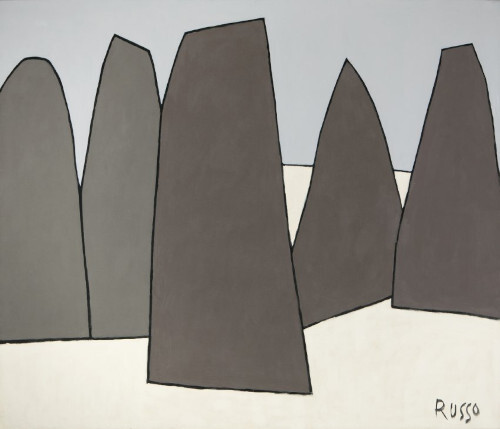Sentinels of Time
As Russo was mainly a figurative artist and a painter of the female nude, Sentinels of Time from 1993 is an extremely rare and unique painting in his oeuvre, but still holds the hallmarks of Russo’s flat and sharp style. It is a monumental canvas, almost the size of a wall, giving the rocks that dominate the canvas a sense of grandeur living up to the name. The painting depicts five angular and large rocks: two on the left of the canvas are more green-grey, the darker grey one in the middle of the canvas is bigger than the others and closer to the viewer, and the last two darker grey rocks on the right. They are all touching at their bottoms and are outlined in a thick black line. The rocks sit on a tan patch, perhaps sand, and the other half of the canvas is a pale blue, perhaps the sky or the ocean.
As the medium is acrylic on canvas, the paint is fairly flat and matte in its finish, but it also gives the paint a more opaque look. The rock forms take up most of the canvas leaving little slivers of land and sky or water, but as the land can only be seen behind the rocks on the right but not on the left, we are left to believe that either the land stops or the rocks are so large they dwarf the land.
There is a sense of community and authority in the rocks; they touch and know one another, they’re the focal point of the painting, and they stand life-size to an average viewer. They live up to their name- Sentinels of Time -because they look to be standing guard in a place devoid of reference to place or time (as was the norm for Russo’s backgrounds). This lack of specifics makes the rocks seem out of time, Stonehenge-like in their mystery and the awe they inspire. A muted sort of sublimity compared to the other more explicit Sublime paintings we’ve seen until now, the rocks are amazing but imposing in the way they sit there and present themselves.
While this painting’s subject matter is unique compared to Russo’s other works, it still takes from his philosophy and style, modifying it to fit the intention of showing nature as eternal.

